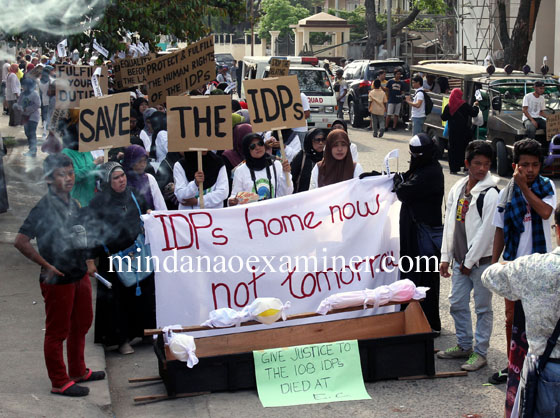ZAMBOANGA CITY (Mindanao Examiner / Apr. 5, 2014) – The United Nations said it is alarmed by the poor conditions of tens of thousands of war refugees still at different filthy evacuation centers and transition sites in Zamboanga City in southern Philippines.
More than 100 refugees had died from diseases in the evacuation centers. Those in the evacuation areas were villagers affected and displaced by rebel attacks mounted in September by the Moro National Liberation Front under Nur Misuari. The attack sparked three weeks of street battles that killed and wounded over 400 people and displaced some 120,000 villagers.
“There is an urgent need to find shelter solutions for these IDPs,” said Jens Laerke, spokesperson for the Office for the Coordination for Humanitarian Affairs, at a press briefing in Geneva, referring to internally displaced persons.
Laerke said in the immediate aftermath of the fighting, OCHA announced that the UN emergency relief fund would allocate $3 million to assist those affected by the violence. More than 10,000 homes were destroyed in and around Zamboanga City and, additionally, nearly 19,000 were displaced in Basilan province.
Citing current figures from the Department of Social Welfare and Development, Laerke said that the remaining IDPs currently lack access to adequate and safe water and sanitation and there are serious health concerns – acute respiratory infections, diarrhoea and skin diseases – due to overcrowding in the two largest evacuation centres hosting some 20,000 IDPs, including the Joaquin Enriquez Memorial Sports Complex in Zamboanga.
“There is, for example, a need for 940 extra latrines to meet global standards. There is also a water shortage because of rationing imposed last month as reservoirs were low in the dry season,” he said.
He said general food distribution to the affected region ended in December 2013. However nearly 12,000 IDPs and returnees continued to benefit from food-for-work programs, and some 11,000 children had received emergency food in their schools.
Laerke said the Zamboanga City government have requested support from humanitarian agencies to assist the families still in evacuation centres and transition sites. “Local authorities have begun implementing their recovery and rehabilitation plan looking at longer-term livelihoods programmes,” he said.
Just recently, hundreds of Muslims protested the government’s failure to facilitate the return of refugees to their original villages. The refugees, many of them Tausug from Sulu; Yakan, from Basilan; and indigenous Badjao tribe from Tawi-Tawi province – engaged in fishing and other traditional livelihoods – were being relocated to the far-flung villages of Tulungatung and Taluksangay from their original habitat in the coastal villages of Rio Hondo and Mariki and other areas.
The government has built bunkhouses as temporary shelters to those affected by the violence, but it also warned that villagers who are not natives of Zamboanga would not be allowed to return to their former abode, unless they can provide certificates to show they are landowners.
Gammar Hassan, one of the refugee leader, said more than 100 people had died from diseases the past months in evacuations sites and the deaths are continuing due to poor health services and malnutrition and lack medical and emergency facilities there. He said the government has prevented them from returning to their villages and has forced the refugees to relocations sites far away.
He said majority of the refugees have opposed the government’s relocation plan to put them in other areas saying it would be extremely difficult for them to rebuild their lives. He also urged the local government to allow the refugees to return to their places instead of holding them in evacuation centers. “Build back better till we all die in pain. Who will enjoy the promised development and rehabilitation? Send us home now, not tomorrow,” Hassan said.
He said even access to clean and potable water and portable toilets are also a huge problem in refugee centers, particularly at the Joaquin Enriquez Memorial Sports Complex.
Just before Christmas, President Benigno Aquino flew to Zamboanga City and briefly inspected temporary shelters occupied by refugees. Aquino assured them of the government’s rehabilitation efforts, saying his administration is working closely with various agencies to rebuild houses destroyed during the war.
Aquino said the government already spent some P273.8 million in relief aid and cash-for-work program for those displaced by the war. He said he also allocated an additional P3.5 billion for the rehabilitation efforts here and these were on top of the millions of pesos in cash and aid that the provincial government of Sulu has sent to Zamboanga to help feed the refugees. The provincial government of Basilan and Tawi-Tawi and other nongovernmental organizations and private companies also donated cash and food aid to refugees in Zamboanga. (Mindanao Examiner)
Courtesy: .mindanaoexaminer.com


Leave a comment